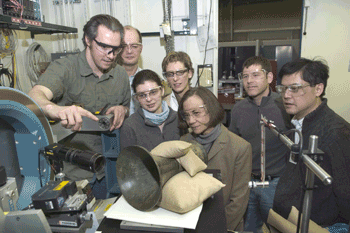When a prestigious art institute owns a precious, ancient artifact and wants to know more about its origin, special non-destructive tools are needed.
Scientists at the U.S. Department of Energy's Argonne National Laboratory are collaborating with colleagues at the Art Institute of Chicago and Northwestern University to investigate the casting technology and the inner structure of ancient bronzes from early Chinese dynasties (1700-221 BCE). One of their most powerful investigative tools is the Advanced Photon Source at Argonne, the most brilliant X-ray source in the Western Hemisphere.
Argonne researchers Dean Haeffner and Jon Almer, along with Professor David Dunand and post-doctoral researcher Marcus Young from Northwestern University and Francesca Casadio and Suzanne Schnepp from the Art Institute of Chicago, work together to understand the creation and corrosion of ancient Chinese bronzes.
“It's an opportunity to understand the story of the craftsmen who created the vessel,” Young said, “and understand their process of working with bronze and the creation of such ancient vessels.”
Understanding the process is of particular interest to Young, who became interested in science after studying fine arts at the University of North Texas — he holds two bachelor's degrees in fine arts, one in ceramics and another in sculpture. Working for some time as an artist and selling his art, currently available at his website, myinfinitevision.com, he also became interested in understanding the process of creating vessels by using a from-scratch approach, such as making his own glazes, clays, and kilns. This interest in the science of art led him to a third bachelor's degree, this time in metallurgical and materials engineering from Colorado School of Mines, and from there to his doctoral thesis entitled, “Strain measurements and imaging of metal matrix composites using high-energy X-rays,” which was completed in 2006 from the Materials Science and Engineering department at Northwestern University.
The high brilliance of X-ray beams available at the Advanced Photon Source permits the use of small beams for diffraction studies, as well as for phase-enhanced imaging for higher contrast than traditional X-ray absorption methods. This means that the researchers can non-destructively sample a number of small areas of the artifact quickly and can also penetrate about 100 times deeper than conventional X-rays.
“One of the things this technique allows us to see is the texture of the grains in the material,” Haeffner said. “If the bronze was cast in ingots, there should be very little texture in the grains; metals usually get texture from mechanical processing, such as rolling. So we get a clue of how the object was made, what sort of technology was used, what tools they had.
“Being able to sample a number of small sample spots all over the vessel at one time gives us truly comprehensive results," he said, "which helps give us a more thorough understanding of how the bronze was worked and shaped.”
The researchers found that the vessel's outer corrosion layer, which is visible optically, is very thin and consists of cuprite and cassiterite. The bulk of the vessel remains uncorroded and is composed of a lead phase and a copper-tin intermetallic phase, which was observed as large, untextured grains, indicating that the vessel was produced by casting, rather than by cold- or hot-working. Results from an earlier study on an ancient Chinese bronze fragment can be found in Applied Physics A (83) 163-168 (2006).
After the success of this initial study on a bronze fragment in 2006, the researchers are continuing in their study investigating complete, large-size Chinese bronze vessels from the Art Institute of Chicago, and Young is working as a post-doctoral researcher on the project under a Mellon Fellowship, which will be completed in July 2007. His next stop is the Ruhr University in Bochum, Germany, where he'll be continuing similar research as a Humboldt fellow. — Catherine Foster
For more information, please contact Catherine Foster (630/252-5580 or cfoster@anl.gov) at Argonne.
Article originally appeared in Argonne News.
Argonne is a U.S. Department of Energy laboratory managed by UChicago Argonne, LLC

